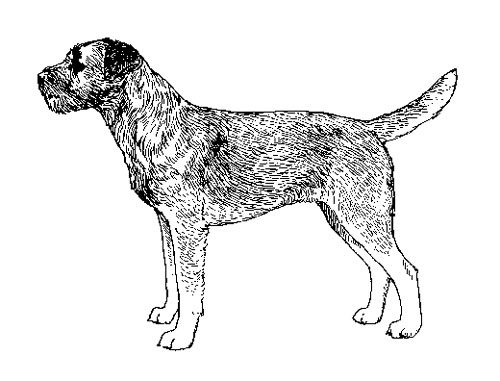Border Terrier
Terrier Group
The goals and purposes of this breed standard include: to furnish guidelines for breeders who wish to maintain the quality of their breed and to improve it; to advance this breed to a state of similarity throughout the world; and to act as a guide for judges.
Breeders and judges have the responsibility to avoid any conditions or exaggerations that are detrimental to the health, welfare, essence and soundness of this breed, and must take the responsibility to see that these are not perpetuated.
Any departure from the following should be considered a fault, and the seriousness with which the fault should be regarded should be in exact proportion to its degree and its effect upon the health and welfare of the dog and on the dog’s ability to perform its traditional work.
History
The Border Terrier is one of the oldest terriers of Great Britain, developed in the border territory surrounding the Cheviot Hills. Farmers and shepherds who needed a dog that had legs long enough to follow a horse, yet was small enough to go to ground after a fox, kept him pure for generations.
The Border Terrier was recognized by the United Kennel Club in 1948.
General Appearance
The Border Terrier is built for endurance and agility. He is strongly made with medium bone and enough length of leg to follow a horse. The breed is rather narrow in shoulder, body and quarters, and is covered with a somewhat broken, close-fitting, intensely wiry jacket. His otter-like head is distinctive. In proportion, the height, measured at the withers, is slightly greater than the distance from the withers to the tail (for example, by about 1½ inches in a 14-pound dog).
Characteristics
The breed is alert, active, agile and capable of squeezing through narrow openings as well as being able to travel rapidly over any type of terrain. They are extremely game when hunting, yet are good-natured, affectionate, obedient and easily trained.
Head
Gives the impression of being like an otter.
SKULL
moderately broad and flat, with plenty of width between the eyes the ears. The stop is a slight, moderately broad curve, not a pronounced indentation. The cheeks are slightly full.
MUZZLE
short and strong.
TEETH
a full complement of strong, white teeth meet in a scissors or level bite.
Serious Faults: Undershot or overshot bites.
EYES
dark with a keen expression.
NOSE
black preferred, but liver or flesh colored are acceptable.
EARS
the ears are small, v-shaped and of moderate thickness. Set somewhat on the side of the head, not high, and drop forward close to the cheeks.
Faults: ears breaking above the level of the skull.
Neck
Of moderate length, gradually widening into the shoulder.
Forequarters
Shoulder blades long and well laid back.
FORELEGS
The straight forelegs are not too heavy in bone. They are placed slightly wider than those of a Fox Terrier.
Body
Deep, narrow and fairly long, capable of being spanned by a man’s hands behind the shoulder blades. Ribcage carried well back, but not overly sprung. Back supple but with no suggestions of weakness.
Hindquarters
Muscular and racy.
HIND LEGS
Long thighs, well-bent stifles and hocks close to the ground.
Feet
Small and compact. The toes point forward and are moderately arched with thick pads.
Tail
Moderately short tail, thick at the base, then tapering. Carried gaily when at attention; and may be dropped when the dog is at ease.
Faults: Tail set on too high. Tail carried over the back.
Coat
Harsh, dense and straight, with close fitting undercoat. The Border Terrier is to be exhibited in as close to natural state as possible. Acceptable trimming includes tidying up the head, neck and feet.
Hide (Skin)
The hide is very thick while remaining loose fitting.
Color
Acceptable colors are red, wheaten, grizzle and tan and blue and tan.
Weight
Dogs: 13 to 15½ pounds. Bitches: 11½ to 14 pounds. These are the preferred weights for Border Terriers in working condition.
Gait
Movement is straight and rhythmical with good length of stride. The breed must be sound enough to follow a horse.
Disqualifications
(A dog with a Disqualification must not be considered for placement in a conformation event, and must be reported to UKC.)
Unilateral or bilateral cryptorchid.
Viciousness or extreme shyness.
Albinism.

Looking for a Dog?
Find a dog that will fit your family.
Note: The breeders on this list are not endorsed by UKC.
Revised April 15, 2007
©Copyright 1991, United Kennel Club
